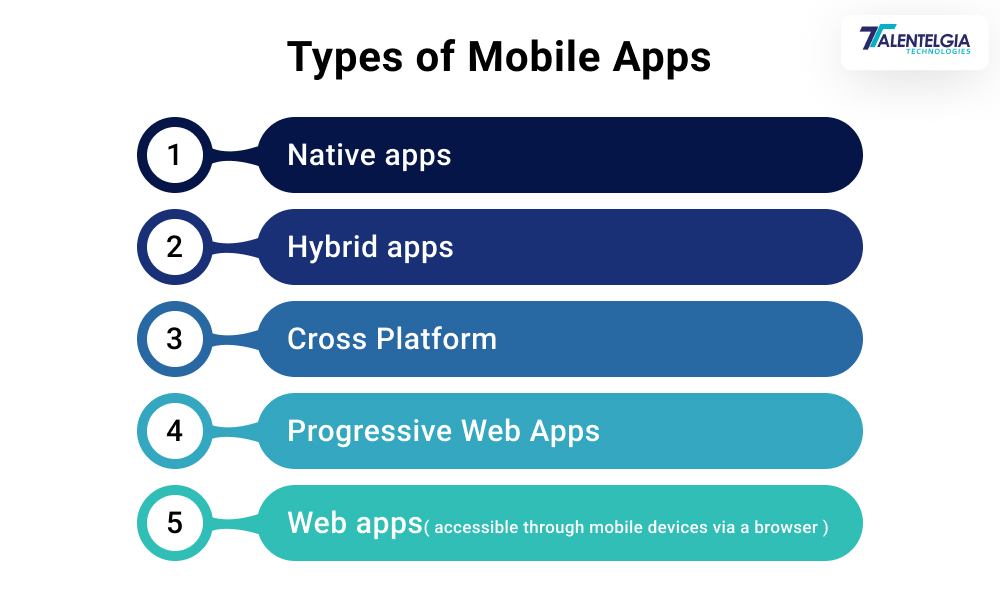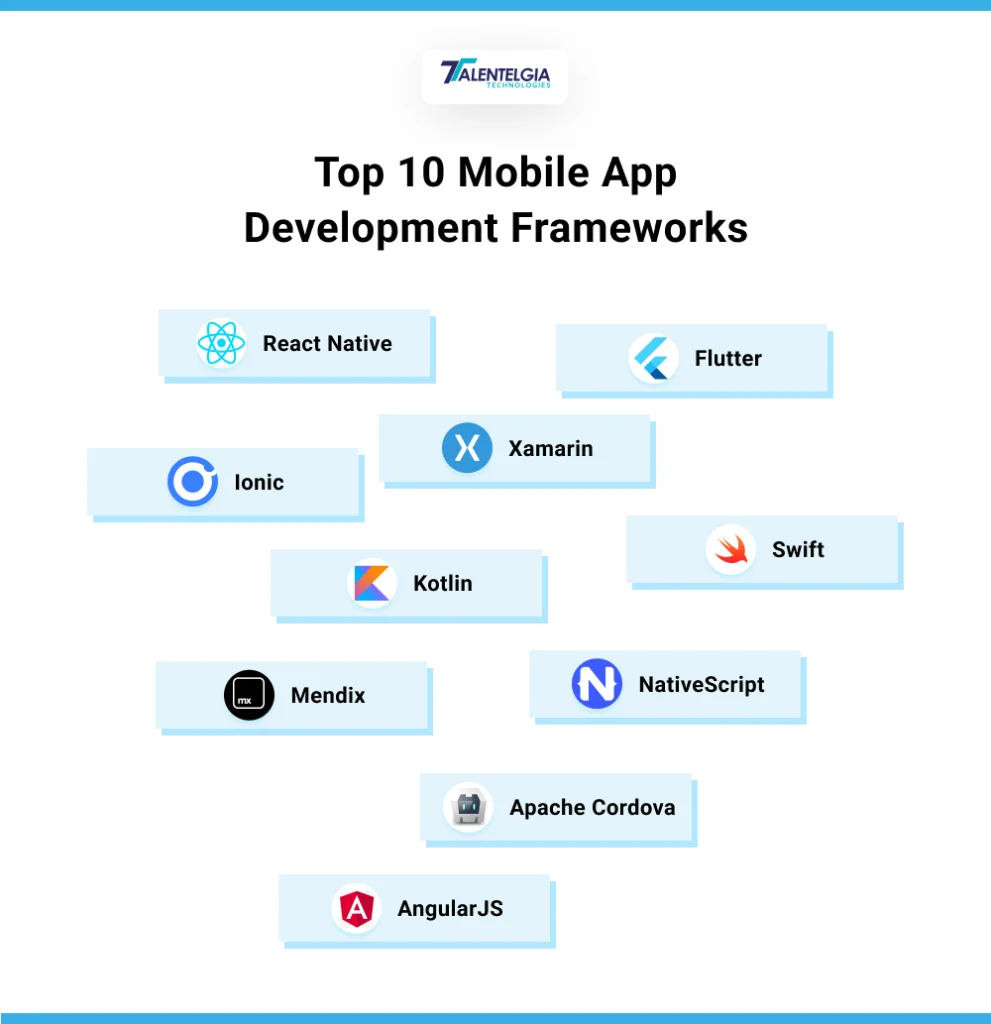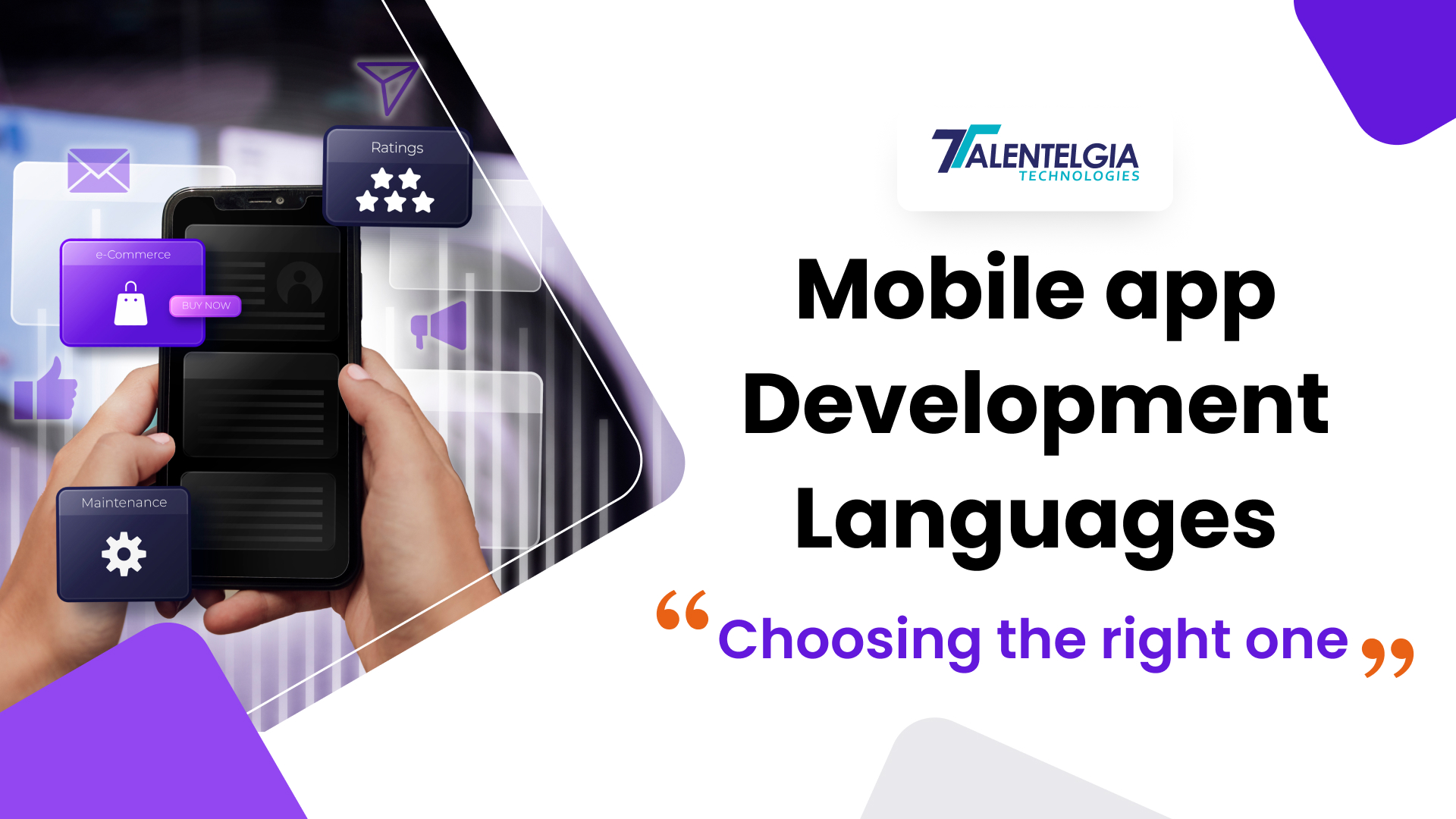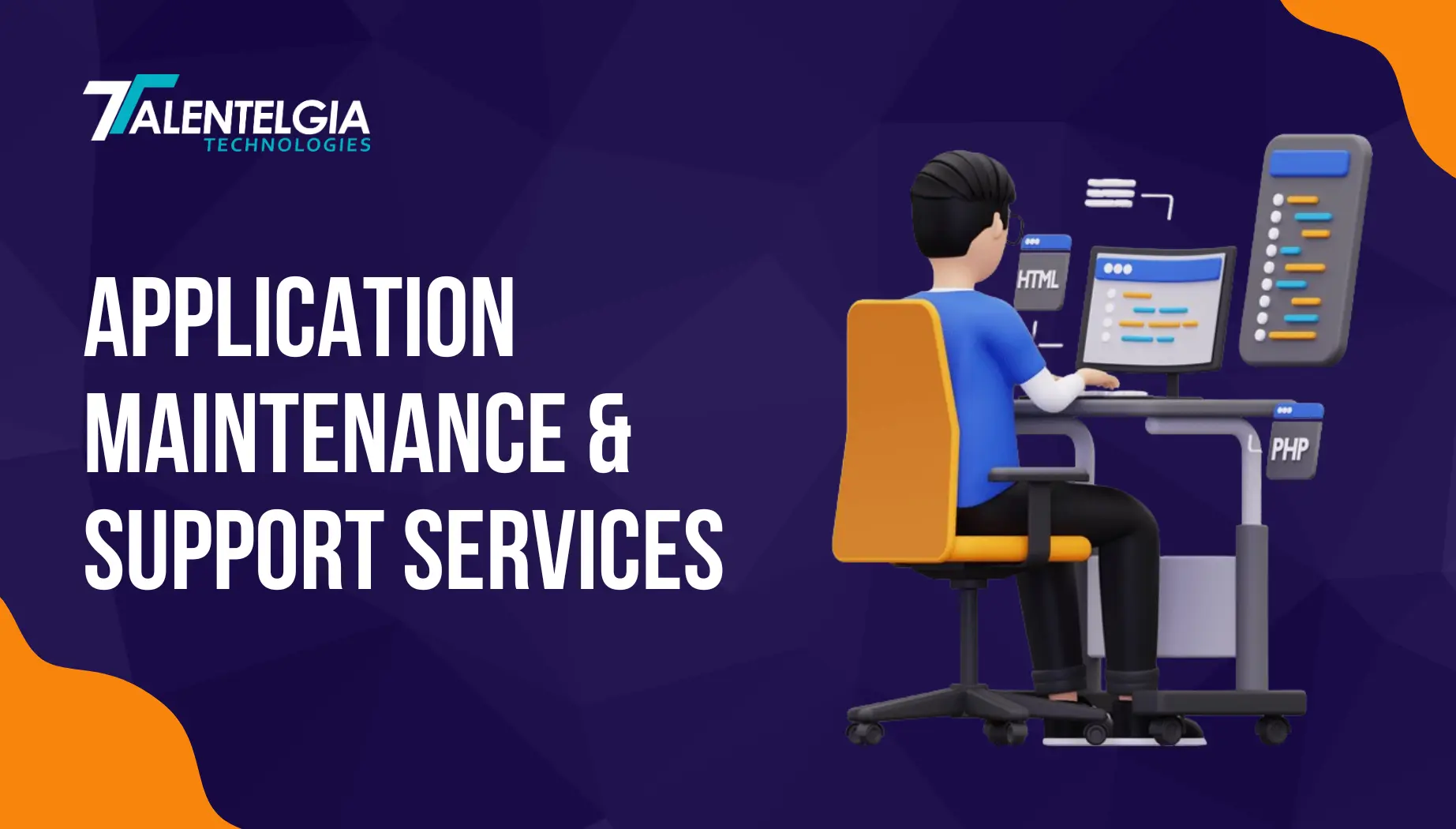Smartphones have become an extension of us. Therefore, the demand for mobile applications is increasing. From changing our daily lives to revolutionizing entire businesses, mobile applications have become indispensable tools in today’s world. But behind every successful mobile app, there is an important decision: choosing the right development language.
This decision may impact or break your app’s performance, usability, and user experience. Complete this mission easily. From native languages like Java and Swift to cross-platform frameworks like React Native and Xamarin, each option has its advantages and benefits.
Exploring all these will help you learn mobile application development with confidence. Join us as we simplify mobile app development terminology and lay out the key concepts you need to consider when choosing the perfect language for your next project measurement. However, it is important to start with the right mobile app development language that suits your needs. Please refer to the list below to choose the right one.
Types of Mobile Apps

Mobile applications have become essential tools to connect with the right target audience.
However, the success of the application often depends on the choice of language and the most suitable framework.
As smartphones and tablets become essential tools for daily work and entertainment, businesses are realizing the enormous potential of the mobile hand in customer engagement, effective work and interaction.
However, choosing the right one among many options for mobile application development language is very important for success.
By understanding the advantages and disadvantages of each development method, organizations can design their mobile applications and maximize efficiency, investment nature, and user experience. Whether it’s native, hybrid, or cross-platform the path to a successful mobile app starts with choosing a language that suits your unique business and user needs.
Native Apps
Native apps are developed for a specific platform (like iOS or Android app development) using specific languages such as Swift for iOS and Java, Kotlin, Scala, and C++. They offer the best performance and unmatched integration with work tools. However, the development of traditional applications requires separate coding for each platform, which brings about further development.
They are preferred in applications that require high performance such as games or multimedia applications. Additionally, platform-specific design and user interface elements can be used to make traditional applications more beautiful.
Cross Platform Apps
Built using frameworks like React native, flutter, Apache Cordova, and Ionic, for sharing across platforms. Although they provide a great user experience, they may not be compatible with the functionality of traditional applications. It allows developers to use their existing web app development skills while accessing tools powered by plugins.
However, hybrid applications may experience performance limitations because they rely on Web views to render content. Enable developers to create a library of code that works across multiple platforms. These applications provide near-perfect performance and user experience in terms of both hardware and functionality.
By using the same platform, businesses can reach a wider audience without sacrificing performance or user experience. However, cross-platform app development services may require specific development skills for certain features or functionality.
Progressive Web Applications
These web applications combine the best features of web and mobile applications to provide the same application experience as web and mobile apps. They are built using Ionic, Angular, React, and Vue.js and also offer offline functionality and push notifications. PWAs can be accessed through a web browser and installed on the user’s device, looking and working like a traditional app. They do not require installation and are updated from the app store, thus reducing user hassles.
PWAs are ideal for businesses that want to improve their online presence and provide a seamless user experience. They are built using web technologies such as HTML, CSS, and JavaScript and do not require installation from the app store.
Web Applications
Although web applications have comparatively fewer features, they are compatible across devices and functions. Mobile users. They can be easily modified and used; This makes them ideal for delivering content or services that do not require access to hardware. However, web applications may face limitations in terms of performance and offline features compared to native or hybrid applications.
Applications are designed to run on multiple operating systems; It allows developers to write code once and distribute it across multiple platforms. They leverage frameworks like React Native, Xamarin, or Flutter to achieve native performance and user experience.
Summary App development is an ongoing process. The Developers can easily make improvements and adjustments using the same framework. They enable businesses to reach a wider audience by targeting both iOS and Android users. However, cross-platform development may require some compromises in terms of optimization and access to platform-specific features. They offer the best performance, user experience, and access to professional tools. Native development allows developers to create efficient applications using platform-specific SDKs and APIs. Native apps provide direct access to hardware, enabling connectivity with devices like GPS, cameras, and push notifications. They are ideal clients who need high-performance applications with fast processing.
The best Mobile App Languages You can Choose from
Choosing the right programming language for mobile application development affects the success and operation of the project. With so many options available, each offering unique features and benefits, deciding can often be overwhelming. From apps known for their performance to new systems designed for specific purposes, the options reflect the needs and preferences of manufacturers around the world.
Based on your needs here is a table we have created for your requirements based on native, cross-platform, or hybrid:
App Development Framework Reach and Usage
Understanding what developers prefer and use is important in the world of app building. Two popular frameworks, React and Flutter, play a big role in this. Let us look at some data from the famous platform Git Hub to compare the popularity of these platforms. Let’s take a closer look at what the numbers tell us about Flutter and React native app development trends during that time.
Stack Overflow Trends (June 2023):
- Popularity: Flutter had a slightly higher popularity percentage at 9.12% compared to React Native’s 8.43%.
- Desired: Flutter was desired by 14.04% of developers, whereas React Native was desired by 11.81%.
- Admired: Flutter had a higher admiration rate at 64.43% compared to React Native’s 54.00.
App Development Frameworks by Popularity (as of 2024)
Based on the different stats and popularity factors we have taken into consideration, Here are 10 of the latest mobile app development languages.
| Category | Framework | Popularity | Pros | Cons |
| Cross-Platform | React Native | Very High | Large community, extensive resources, single codebase for multiple platforms | Can be slower than native, requires JavaScript knowledge |
| Cross-Platform | Flutter | High | Fast development, good performance, single codebase for multiple platforms | Newer framework, smaller community compared to React Native |
| Cross-Platform | Xamarin | High | Mature framework, good for enterprise apps, integrates with Visual Studio | Requires knowledge of C#, platform-specific considerations |
| Cross-Platform | Ionic | Medium | Uses familiar web technologies (HTML, CSS, JavaScript), large community | Can be less performant than native apps |
| Native (Android) | Kotlin | High | Modern language, well-suited for Android development | Java still widely used |
| Native (iOS) | Swift | High | Modern language, designed for Apple platforms | Objective-C still used in some legacy apps |
Top 10 Mobile App Development Frameworks
The best frameworks for your mobile app development project are supported by multiple contributing factors, but include the type of app you are working on, the platform that is to be used, and the skills of your team.
React Native
React Native is a cross-platform, open-source framework managed by the Facebook Project. It was made public in 2015. This has introduced a new paradigm where a developer can write the code coinciding with both iOS and Android. Its large community, deep dive documentation, and a boast of tools and libraries are of great value. It enables quick development using features such as real-time reloading that focuses on the more demanding need.
Flutter
Created by Google, Flutter began its life as a young carrier pigeon in 2018. However, it does not have the speed as quick as traditional development, it is easy to get started and has a wide open space for can be applied to various applications. In this language, it is Dart allowing for the creation of designs in a customized fashion complete with a reactive model. Flutter is fast as well as has a hot reload feature which enables the app to show instant changes.
It is very rich in plugins and packages, which both are for native functions and third parties. Flutter enables especially visual customization and has a high-performance business layer for cross-platform systems.
Xamarin
Xamarin will deeply facilitate you with the opportunity to code native apps for iOS, Android, and Windows in C#. Created by Miguel de Icaza and Nat Friedman, Xamarin emerged on the market in 2011. This language allows reusing the code without making any changes to the traditional workflow and the ability to run this across platforms. It has a nice compatibility with Visual Studio and is featured with a plethora of packages and tools. Xamarin performs well and gets compared to the user experience of software on smartphones that many people use for their businesses.
This programming language allows developers to share code across platforms while maintaining access to traditional workflows. It works well with Visual Studio and has many libraries and tools. Xamarin offers excellent performance and user experience, making it suitable for business use.
Ionic
Founded by Max Lynch, Ben Sperry, and Adam Bradley, Ionic was released in 2013. Ionic is a framework for creating different mobile applications using technologies such as HTML, CSS, and JavaScript / TypeScript. It uses coding libraries to create native-like experiences on iOS, Android, and the web. Ionic has multiple user interfaces and pre-built templates for rapid development. It integrates with Angular and is popular in hybrid applications.
Kotlin
Kotlin is a programming language for Android app development. It’s simple, neat, and works well with existing Java code. Kotlin is equipped with modern features such as coroutines for asynchronous programming and continues to work on API development. It was developed by JetBrains and Kotlin was released in 2011, integrating seamlessly with Android Studio, and has extensive support. Kotlin is growing in popularity due to its efficiency and productivity.
Swift
Swift is preferred by developers for iOS app development services (iOS and macOS). It comes with modern features like appearance options and clean rules. Swift app development is fast as this language has good memory management. Developed by Apple Inc., Swift was released in 2014. It works well with existing Objective-C code and is designed to make developers more productive. It has become the preferred language for app development.
NativeScript
NativeScript is the framework for creating mobile applications using web languages such as JavaScript, TypeScript or Angular. This platform was built by Progress Software Corporation, and NativeScript and released in 2014. It creates cross-platform applications that can access traditional APIs and client interfaces. NativeScript has many plugins and integrations and works well with Angular. Provide traditional functionality and user experience.
Mendix
Mendix is a low-cost tool for developing web and mobile applications without requiring much coding knowledge. This platform was released in 2005 and has optical design tools and integration to speed up development. Mendix enables business users, developers, and IT teams to integrate operational applications. It has a drag-and-drop interface and automatic markup for easier application development. Mendix is scalable and secure for enterprise-level applications.
Apache Cordova
This framework was originally developed by Nitobi, and later acquired by Adobe Systems, Apache Cordova was released in 2009This is an ideal framework for building cross-platform mobile applications using technologies such as HTML, CSS, and JavaScript. It connects the web API and local devices. Cordova applications can be deployed on iOS, Android, and Windows. It has many plugins and extensions to add functionality. Cordova is ideal for hybrid applications that use web technologies and traditional workflows.
AngularJS
AngularJS is a JavaScript framework for dynamic web development. It can be used with frameworks like Ionic or NativeScript for cross-platform use. AngularJS has features like data binding and web development. Developed by Google, AngularJS was released in 2010, this framework includes tools and libraries for complex applications. AngularJS is suitable for both single-page and enterprise applications due to its scalability and extensibility.

How to Find the Right Language?
We hope the list above will help you find the right mobile app development language. However. Along with you also need to be careful about some additional factors like:
Target Platform
Consider the platform your app will run on. For iOS devices like iPhone and iPad, you should use languages like Swift or Objective-C. Most developers prefer Java or Kotlin for Android. You can use the same language for both platforms or vice versa.
Cross-platform frameworks like Flutter or React Native also provide the flexibility to write code once and deploy it across multiple platforms. This can be useful if you want to target iOS and Android app development.
Purpose of the Application
Know the purpose of the application. You should be able to define if it is a game, a productivity tool, a social networking site, or something else. Each type of application development has its own rules and challenges. For example, a game may require good graphics and audio capabilities, which may affect your choice of programming language.
Developer tools can make languages like JavaScript, Python, or Ruby even better by prioritizing integration with backend services and libraries. Understanding the specific needs of your target application will help you choose a language that suits your target audience.
Available Resources
Analyze the resources you have for app development. Some languages may have a more rigorous course or require special equipment, which will impact your progress in terms of time and money. Also, evaluate your team’s development skills and knowledge of different languages and processes.
Choosing a language that suits your team’s skills can increase productivity and reduce the need for additional training or layoffs. It is also important to consider the availability of community support, documentation, and third-party libraries; because these resources can quickly influence your development and work well.
Developer Preferences
Know the preferences and comfort of the developers who will work on the project. Each language has different syntaxes, paradigms, and ecosystems, and these can confuse developers. Some developers may have experience or preferences for certain languages, while others may prefer to learn new technologies.
Creating an environment where developers feel empowered and committed to their choices can lead to meaningful and fulfilling work. Encourage open communication and collaboration within the development team to ensure everyone’s interests and concerns are taken into account in decisions.
Conclusion
The mobile app development language you use directly impacts performance, compatibility, and security. By analyzing everything carefully and taking into account your specific needs, you can make more informed decisions to achieve your goals and objectives.
The choice depends on individual needs, project scope, decision-making process, and team dynamics. What works in one application may not work in another, and content that appeals to one developer may not appeal to another. The specific requirements of the program and the programming language you need. We hope the information shared above will provide you with the knowledge and understanding you need to make better decisions.


 Healthcare App Development Services
Healthcare App Development Services
 Real Estate Web Development Services
Real Estate Web Development Services
 E-Commerce App Development Services
E-Commerce App Development Services E-Commerce Web Development Services
E-Commerce Web Development Services Blockchain E-commerce Development Company
Blockchain E-commerce Development Company
 Fintech App Development Services
Fintech App Development Services Fintech Web Development
Fintech Web Development Blockchain Fintech Development Company
Blockchain Fintech Development Company
 E-Learning App Development Services
E-Learning App Development Services
 Restaurant App Development Company
Restaurant App Development Company
 Mobile Game Development Company
Mobile Game Development Company
 Travel App Development Company
Travel App Development Company
 Automotive Web Design
Automotive Web Design
 AI Traffic Management System
AI Traffic Management System
 AI Inventory Management Software
AI Inventory Management Software
 AI Software Development
AI Software Development  AI Development Company
AI Development Company  AI App Development Services
AI App Development Services  ChatGPT integration services
ChatGPT integration services  AI Integration Services
AI Integration Services  Generative AI Development Services
Generative AI Development Services  Natural Language Processing Company
Natural Language Processing Company Machine Learning Development
Machine Learning Development  Machine learning consulting services
Machine learning consulting services  Blockchain Development
Blockchain Development  Blockchain Software Development
Blockchain Software Development  Smart Contract Development Company
Smart Contract Development Company  NFT Marketplace Development Services
NFT Marketplace Development Services  Asset Tokenization Company
Asset Tokenization Company DeFi Wallet Development Company
DeFi Wallet Development Company Mobile App Development
Mobile App Development  IOS App Development
IOS App Development  Android App Development
Android App Development  Cross-Platform App Development
Cross-Platform App Development  Augmented Reality (AR) App Development
Augmented Reality (AR) App Development  Virtual Reality (VR) App Development
Virtual Reality (VR) App Development  Web App Development
Web App Development  SaaS App Development
SaaS App Development Flutter
Flutter  React Native
React Native  Swift (IOS)
Swift (IOS)  Kotlin (Android)
Kotlin (Android)  Mean Stack Development
Mean Stack Development  AngularJS Development
AngularJS Development  MongoDB Development
MongoDB Development  Nodejs Development
Nodejs Development  Database Development
Database Development Ruby on Rails Development
Ruby on Rails Development Expressjs Development
Expressjs Development  Full Stack Development
Full Stack Development  Web Development Services
Web Development Services  Laravel Development
Laravel Development  LAMP Development
LAMP Development  Custom PHP Development
Custom PHP Development  .Net Development
.Net Development  User Experience Design Services
User Experience Design Services  User Interface Design Services
User Interface Design Services  Automated Testing
Automated Testing  Manual Testing
Manual Testing  Digital Marketing Services
Digital Marketing Services 
 Ride-Sharing And Taxi Services
Ride-Sharing And Taxi Services Food Delivery Services
Food Delivery Services Grocery Delivery Services
Grocery Delivery Services Transportation And Logistics
Transportation And Logistics Car Wash App
Car Wash App Home Services App
Home Services App ERP Development Services
ERP Development Services CMS Development Services
CMS Development Services LMS Development
LMS Development CRM Development
CRM Development DevOps Development Services
DevOps Development Services AI Business Solutions
AI Business Solutions AI Cloud Solutions
AI Cloud Solutions AI Chatbot Development
AI Chatbot Development API Development
API Development Blockchain Product Development
Blockchain Product Development Cryptocurrency Wallet Development
Cryptocurrency Wallet Development About Talentelgia
About Talentelgia  Our Team
Our Team  Our Culture
Our Culture 
 Healthcare App Development Services
Healthcare App Development Services Real Estate Web Development Services
Real Estate Web Development Services E-Commerce App Development Services
E-Commerce App Development Services E-Commerce Web Development Services
E-Commerce Web Development Services Blockchain E-commerce
Development Company
Blockchain E-commerce
Development Company Fintech App Development Services
Fintech App Development Services Finance Web Development
Finance Web Development Blockchain Fintech
Development Company
Blockchain Fintech
Development Company E-Learning App Development Services
E-Learning App Development Services Restaurant App Development Company
Restaurant App Development Company Mobile Game Development Company
Mobile Game Development Company Travel App Development Company
Travel App Development Company Automotive Web Design
Automotive Web Design AI Traffic Management System
AI Traffic Management System AI Inventory Management Software
AI Inventory Management Software AI Software Development
AI Software Development AI Development Company
AI Development Company ChatGPT integration services
ChatGPT integration services AI Integration Services
AI Integration Services Machine Learning Development
Machine Learning Development Machine learning consulting services
Machine learning consulting services Blockchain Development
Blockchain Development Blockchain Software Development
Blockchain Software Development Smart contract development company
Smart contract development company NFT marketplace development services
NFT marketplace development services IOS App Development
IOS App Development Android App Development
Android App Development Cross-Platform App Development
Cross-Platform App Development Augmented Reality (AR) App
Development
Augmented Reality (AR) App
Development Virtual Reality (VR) App Development
Virtual Reality (VR) App Development Web App Development
Web App Development Flutter
Flutter React
Native
React
Native Swift
(IOS)
Swift
(IOS) Kotlin (Android)
Kotlin (Android) MEAN Stack Development
MEAN Stack Development AngularJS Development
AngularJS Development MongoDB Development
MongoDB Development Nodejs Development
Nodejs Development Database development services
Database development services Ruby on Rails Development services
Ruby on Rails Development services Expressjs Development
Expressjs Development Full Stack Development
Full Stack Development Web Development Services
Web Development Services Laravel Development
Laravel Development LAMP
Development
LAMP
Development Custom PHP Development
Custom PHP Development User Experience Design Services
User Experience Design Services User Interface Design Services
User Interface Design Services Automated Testing
Automated Testing Manual
Testing
Manual
Testing About Talentelgia
About Talentelgia Our Team
Our Team Our Culture
Our Culture

















 Write us on:
Write us on:  Business queries:
Business queries:  HR:
HR: 




